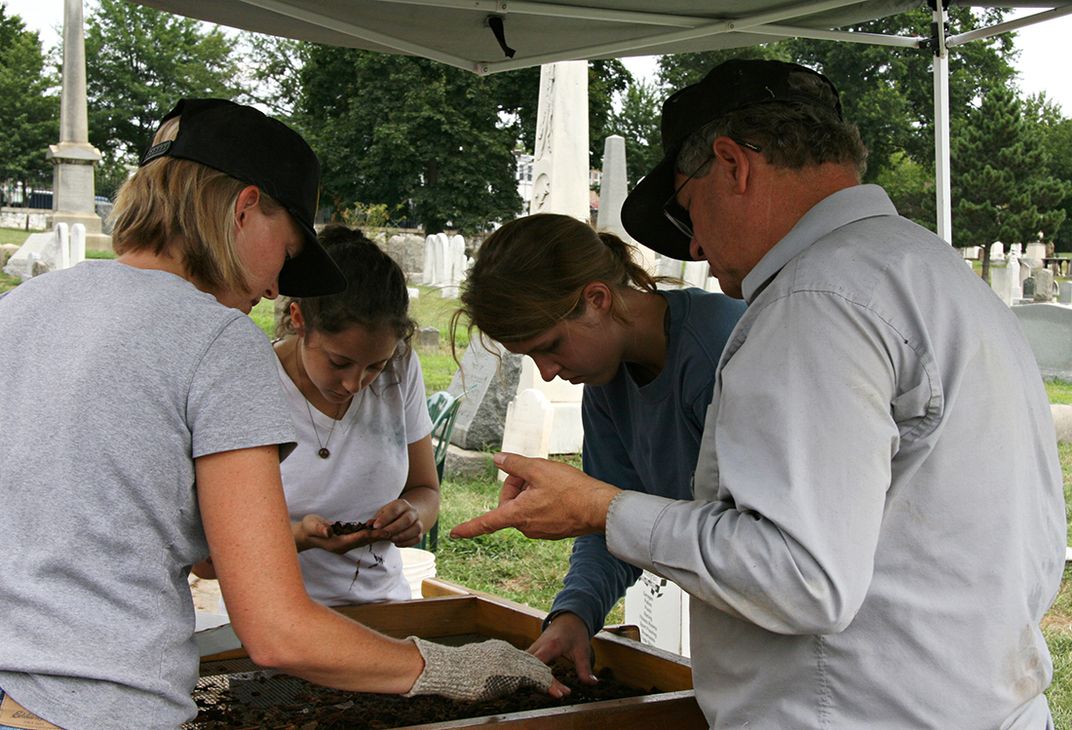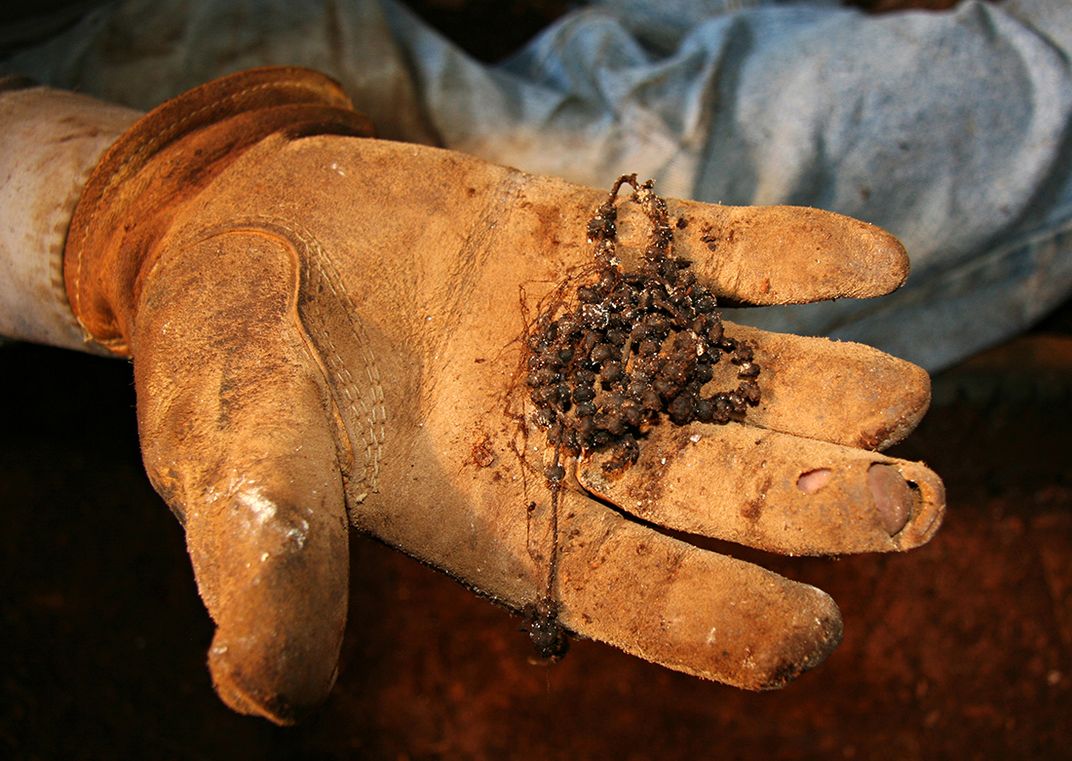To Discover What Life Was Like in 19th Century D.C., a Smithsonian Scientist Investigates a Tomb
Forensic anthropologist Douglas Owsley digs into an 1835 vault and reveals the startling history of a famous Washington family
/https://tf-cmsv2-smithsonianmag-media.s3.amazonaws.com/filer/d5/cd/d5cdbb7a-5260-42cd-b089-cceab517d86a/before.jpg)
After more than 150 years of time, weather and even vandals, the vault holding the remains of a once-prominent Washington family was a mess. Located in D.C.'s Historic Congressional Cemetery, the Causten Vault—a semi-underground, domed-chamber—was structurally in peril.
“All the mortar had fallen away from the bricks [and] the barrel roof had begun to collapse,” says the cemetery’s president, Paul Williams.
The inside of the tomb had fared even worse. The wooden shelves that held the caskets of nearly two dozen individuals had disintegrated. Bones were exposed. Restoring the vault without disturbing the remains would be impossible. Workers would step on them, and the bones would be exposed to the elements.
So, in 2009, the cemetery called on forensic anthropologist Douglas Owsley, of the National Museum of Natural History for help. And today, after years of work to sort and catalogue the remains, as well as research the family’s history, the scientist and his colleagues finally returned the bones to the cemetery, where the vault has been restored. The work, Owsley says, not only helps the cemetery and the living descendants of those buried in the tomb, but also aids in his efforts to document life in the Chesapeake region over the last 400 years.
Congressional Cemetery, located about a-mile-and-a-half east of the U.S. Capitol in southeast Washington, D.C., is a somewhat quirky spot with a long history. Founded in 1807, the cemetery is not owned by the government, though it gets its name from having served as a resting place for many legislators and government officials. That includes 16 senators, 68 representatives and Vice President Elbridge Gerry, a signer of the Declaration of Independence. Such a spot was needed early on in American history because it was not possible to transport bodies of the deceased long distances in the hot summer months.
The 35-acre cemetery is now home to not just long-dead legislators (since 1878, most have chosen to be buried closer to home) but more than 65,000 burials, and it is still an active cemetery. To be buried there, “you just have to be dead,” notes the Congressional Cemetery website.
Such frank language reflects the respective, but somewhat irreverent, ways of the cemetery. About one-quarter of the site’s operating funds, for instance, come from a unique source: a dogwalking program in which paying members are allowed to use the grounds as a leash-free dog park. Adding to its eccentricity, past events held there have included a birthday party for John Phillip Sousa—the march composer who directed the U.S. Marine Band in the late 1800s—and a “Ghosts and Goblets” Halloween-themed fundraiser.
Tourists and locals alike can be found wandering the cemetery, visiting the graves of former Washingtonians such as Civil War photographer Mathew Brady, FBI director J. Edgar Hoover and Belva Ann Lockwood, the first female attorney allowed before the U.S. Supreme Court. More recent burials include Warren M. Robbins, who established the National Museum of African Art.
In recent years, the cemetery has been working to conserve and restore the grounds, which fell into disrepair in the 1960s and 1970s. Fractured and fallen gravestones can still be found across the site, though the cemetery has been working to upright and pin the stones so they are not easily knocked over again. Many of the original vaults, which hold the remains of formerly prominent Washington families, had begun to disintegrate, and some disappeared entirely. “Two-hundred and seven years later, [the site] will probably show its wear and tear,” notes Williams.
Owsley and the cemetery had an established relationship when they called him in 2009. The bone expert had matched up a skull found in an old tin box with the remains of cemetery resident William Wirt, a former U.S. attorney general and a prosecutor in the treason trial of Aaron Burr, for example. Owsley and other Smithsonian researchers participated in the excavation of the tomb of General Alexander Macomb, a hero of the War of 1812. And they had been called in to deal with the remains found in other crumbling vaults. “This is a public service,” Owsley says.
The Causten Vault held the remains of members of the Causten family, which in the 19th century was led by James Causten, an international lawyer and consul to the nations of Chile and Ecuador. Causten had the vault built in 1835, after the death of his first son, and it would eventually hold the remains of 22 members of the extended Causten family, including 4-year-old Josephine Shriver, whose mother, Henrietta Jane Causten, had married Joseph Shriver. (The Shriver family rose to prominence in the 20th century when Eunice Kennedy, younger sister of President John F. Kennedy, married Robert Sargent Shriver, Jr.)
Owsley and his colleagues began by removing all the remains from the Causten Vault, in what Owsley calls an “indoor archaeological investigation.” As the planking and caskets disintegrated over time, the remains pancaked. Owsley’s team sorted through each layer and then removed the remains to his laboratory back at the museum. (They found evidence the tomb had been vandalized at one time—one man buried there is now missing his cranium.)
There, Owsley continued sorting and matching bones. From the bones, he could determine the gender and approximate age of the individual. The shape of the metal casket handles helped to narrow when that person was buried—the style of the hardware is often distinctive to a time period, Owsley says. Meanwhile, Deborah Hull-Walski, a collections manager in the museum’s anthropology department, was putting together a complete genealogy of the family.
The team eventually determined that the tomb held the remains of 16 people, including 13 skeletons and three still preserved in their coffins. The bodies of several individuals—those whose coffins had sat near the bottom of the vault—had completely disintegrated. “That’s not unique to this tomb,” Owsley notes. In the damp conditions found at the lower levels, a mineral called brushite begins to form and breaks up the bones.
Owsley continued sorting and identifying bones, matching them with records and refining his information, repeating the process three times to be sure that he could match the correct name with each set of remains. The now-separated skeletons were finally carefully packed into white plastic bins, each labeled with the person’s name. The cemetery will transfer the remains to a coffin before they are reinterred within the vault.
Matching Owsley’s findings with Hull-Walski’s genealogical research, the family now has a rich, if somewhat tragic, history. (The Causten’s living family members will receive a copy of the research later this summer.) Though James Hyman Causten Sr. lived a long life, dying in his 80s of a heart attack, “his kids were not so lucky,” Owsley notes. The Carvallo branch of the family, for example, lost five of six children. Two small children buried in the vault, aged three and seven months, died of dysentery.
Those who were buried in the vault weren’t its only residents, it turns out. Hull-Walski’s research also revealed that the Causten Vault had eight temporary burials during its time, including two former first ladies. One of these was Dolley Madison, the wife of President James Madison whose niece, Annie Payne, married into the Causten family. Dolley died in 1849 and was first interred in Congressional Cemetery’s Public Vault for two years. Annie Payne Causten then moved the former first lady’s remains across the lane to the Causten Vault. There her casket stayed until 1858, when Dolley Madison was finally laid to rest next to her husband in the Madison family cemetery on the grounds of the Montpelier in Virginia.
Madison was briefly joined in the Causten Vault by Louisa Adams, wife of President John Quincy Adams, after she died in May 1852. Her body was then removed to the United First Parish Church in Quincy, Massachusetts, where she is entombed with her husband.
Remains like those found in the Causten Vault have proven invaluable for Owsley’s research, he says. By studying bones left behind after death, he can determine an individuals, age, gender, physical size and dental health—even whether they had infections, arthritis or some type of trauma. Bone chemistry can tell him about exposure to toxic metals like lead. But, he says, “context is crucial,” and it’s rare to have so much additional information about how people lived and died long ago.
Through the remains of people long dead, Owsley is hoping to paint a picture of life in the Chesapeake area over the last 400 years. He has concentrated on the 17th century—reconstructing life in Jamestown, Virginia, for instance—but has begun to look farther afield, at individuals in Ghana and England, for example. He hopes to be able to compare rich and poor, urban and rural, slave and white, “to look at this process of becoming American,” he says.
The Causten Vault is one piece of that grander puzzle. And, Owsley says, “it enhances what we can do with the [remains] where we don’t have that record.”
/https://tf-cmsv2-smithsonianmag-media.s3.amazonaws.com/accounts/headshot/Sarah-Zielinski-240.jpg)
/https://tf-cmsv2-smithsonianmag-media.s3.amazonaws.com/filer/7a/cf/7acf6d18-4181-4966-b124-fe1b859c98d3/vault.jpg)





/https://tf-cmsv2-smithsonianmag-media.s3.amazonaws.com/accounts/headshot/Sarah-Zielinski-240.jpg)